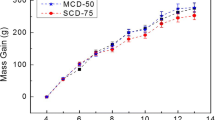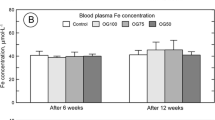Summary
Thirty-six 3-week-old male Wistar rats were labeled with a single intraperitoneal tetracycline injection. Twenty-four of them were then fed a Ca-deficient basal diet for 3 weeks, while the control group received the basal diet supplemented with CaCO3 (12 g/kg). The tetracycline labeling was then repeated and six animals in each group were decapitated. The diet of the remaining formerly Ca-deficient animals was returned to normal, and half the test rats also received xylitol supplementation (50 g/kg). After 4 weeks of rehabilitation the labeling was repeated and the animals were decapitated and their tibias were prepared.
The tibias were measured in terms of weight and density and cross sections were prepared for the examination of mineral content. Bone element analysis was performed by scanning electron microscopy with electron-probe microanalysis, examining separately the bone areas formed during the various dietary periods. Areas of the former Ca-deficient and newly formed cortical bone were identified by tetracycline fluorescence under ultraviolet light, and the amount of cortical bone in each group was measured.
The mineralization-promoting effect of dietary xylitol as compared with CaCO3 supplementation alone was seen more clearly in the newly formed periosteal bone than in remineralization of the formerly Ca-deficient bone, the concentrations of Ca and P being significantly elevated (P < 0.05), as also was the total mineral content (P < 0.01). The cortical bone volume was similar following the CaCO3 and CaCO3 + xylitol supplementations, suggesting unaltered formation of the organic matrix.
The results show that the effect of xylitol on bone during dietary Ca rehabilitation particularly concerns newly formed bone mineral. This may be due to the slow process of remodeling in the former mineralized bone or to xylitol induced effects on osteoblast and/or osteoclast metabolism.
Similar content being viewed by others
References
Knuuttila M, Svanberg M, Hämäläinen M (1989) Alteration in bone composition related to polyol supplementation of the diet. Bone Miner 6:25–31
Hämäläinen MM, Knuuttila M, Svanberg M, Koskinen T (1990) Comparison of the effect of gluconate, lactose and xylitol on bone recalcification in calcium-deficient rats. Bone 11:429–438
Pansu D, Chapuy MC, Milani M, Bellaton C (1976) Transepithelial calcium transport enhanced by xylose and glucose in the rat jejunal ligated loop. Calcif Tissue Res 21:45–52
Hämäläinen MM, Mäkinen KK, Parviainen MT, Koskinen T (1985) Peroral xylitol increases calcium absorption in the rat independently of vitamin D action. Mineral Electrol Metab 11:178–181
Angyal SJ (1974) Complexin of polyols with cations. Tetrahedron 30:1695–1972
Sissons HA, Kelman GJ, Marotti G (1984) Mechanism of bone resorption in calcium-deficient rats. Calcif Tissue Int 36:711–721
Sissons HA, Kelman GJ, Ling L, Marotti G, Canè V, Muglia MA (1990) A light and scanning electron microscopic study of osteocyte activity in calcium-deficient rats. Calcif Tissue Int 46:33–37
Bar-Shavit Z, Teitelbaum SL, Reitsma P, Hall A, Pegg LE, Trial J, Kahn AJ (1983) Induction of monocytic differentiation and bone resorption by 1.25-dihydroxyvitamin D3. Proc Natl Acad Sci USA 80:5907–5911
Raisz LG, Trummel CL, Holick MF, DeLuca HF (1972) 1.25dihydroxycholecalciferol: a potent stimulator of bone resorption in tissue culture. Science 175:768–769
Stern PH, Mavreas T, Trummel CL, Schnoes HK, DeLuca HF (1976) Bone-resorbing activity of analogues of 25-hydroxycholecalciferol and 1.25-dihydroxycholecalciferol: effects of side chain modification and stereoisomerization on responses of fetal rat bones in vitro. Mol Pharmacol 12:879–886
Mäkinen KK, Söderling E (1984) Solubility of calcium salts, enamel and hydroxyapatite in aqueous solution of simple carbohydrates. Calcif Tissue Int 36:64–71
Smits MT, Arends J (1988) Influence of extraoral xylitol and sucrose dippings on enamel demineralization in vivo. Caries Res 22:160–165
Arends J, Christoffersen J, Schuthof J, Smits MT (1984) Influence of xylitol on demineralization of enamel. Caries Res 18:296–301
Vissink A, 's-Gravenmade EJ, Gelhard TBFM, Panders AK, Franken MH (1985) Rehardening properties of Mucin- or CMC-containing saliva substitutes on softened human enamel. Caries Res 19:212–218
Bäissler KH (1977) Biochemistry of xylitol. In: Counsell JN (ed) Xylitol. Applied Science Publisher, London, pp 35–41
Froesch ER, Jakob A (1974) The metabolism of xylitol. In: Sipple HL, McNutt KW (eds) Sugars in nutrition. Academic Press, New York, pp 241
Shapiro IM, Golub EE, Kakuta S, Hazelgrove J, Havery J, Chance B, Frasca P (1982) Initiation of endochondral calcification is related to changes in the redox state of hypertrophic chondrocytes. Science 217:950–952
Oimomi M, Sakai M, Ohara T, Igaki N, Nakamichi T, Nishimoto S, Hata F, Baba S (1989) Acceleration of fructose mediated collagen glycation. J Int Med Res 17:249–253
Author information
Authors and Affiliations
Rights and permissions
About this article
Cite this article
Svanberg, M., Knuuttila, M. The effect of dietary xylitol on recalcifying and newly formed cortical long bone in rats. Calcif Tissue Int 53, 135–138 (1993). https://doi.org/10.1007/BF01321892
Received:
Revised:
Issue Date:
DOI: https://doi.org/10.1007/BF01321892




